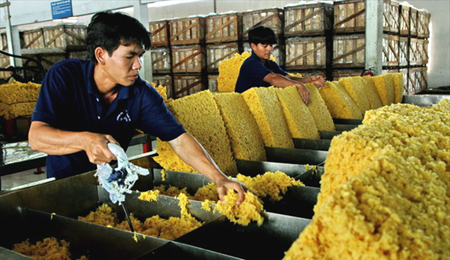HCM CITY (VNS) — The rubber industry expects another difficult year due to falling prices and low demand in the global market, the Viet Nam Rubber Group has said.

Viet Nam exported 1.14 million tonnes of natural rubber worth US$1.53 billion last year, an increase of 7.1 per cent in volume but a decrease of 13.5 per cent in value as prices dropped. — Photo moit.gov.vn
Speaking at a review meeting in HCM City on Friday, Tran Thoai, the company’s deputy general director, said Viet Nam exported 1.14 million tonnes of natural rubber worth US$1.53 billion last year, an increase of 7.1 per cent in volume but a decrease of 13.5 per cent in value as prices dropped.
VRG accounted for 322,896 tonnes, falling just short of the target, he said.
The average price was around VND30.5 million ($1,358) per tonne last year compared to VND51.8 million ($2,307) in 2014, and it is likely to fall to around VND26 million ($1,158) this year, he said.
With natural rubber prices forecast to continue falling this year, the group expects revenue and profit to go down, he said.
“Earnings from other products like rubber wood, industrial rubber production and building industrial parks would increase this year, but it will be hard to make up the decrease from natural rubber exports.
“In addition, the group will continue to divest non-core operations, leading to revenue reduction this year.”
Therefore, the group has set itself a revenue target of VND17.8 trillion ($792.8 million), or just 84 per cent of last year’s figure, and a profit target of VND2.57 trillion ($114.4 million) compared to VND2.7 trillion last year, he said.
To achieve the targets, it plans to step up trade promotion to expand its share in both domestic and foreign markets.
The group urged its subsidiaries to try and cut production costs to around VND25 million per hectare.
Besides, rubber wood processing plants need to improve their performance and market share, it said.
Deputy Minister of Agriculture and Rural Development Ha Cong Tuan told the meeting that amid its current difficulties the rubber industry should speed up restructure to focus on rubber products with high global demand and developing in a sustainable manner.
Besides making efforts to boost exports to existing markets, companies should look for new markets and improve product quality, he said.
Japan is a promising market for Vietnamese rubber products and it can import 200,000 tonnes of high-quality natural rubber, while Viet Nam exported just 700 tonnes to it, he said.
Despite faced with many difficulties last year, the group managed to enjoy pre-tax profits of VND2.7 trillion, meeting 97.6 of its plan, with the main contributors being industrial rubber, industrial parks, and hydroelectric projects.
Profits from natural rubber exports accounted for only 8.7 per cent, Thoai said. — VNS

























